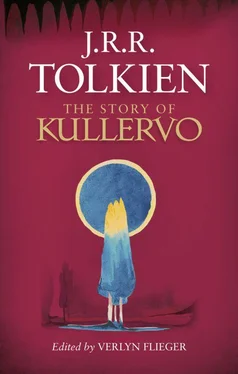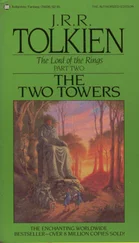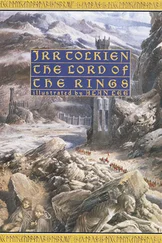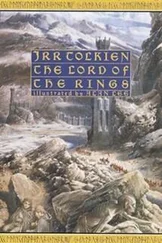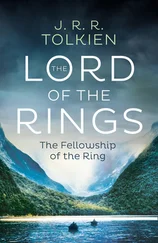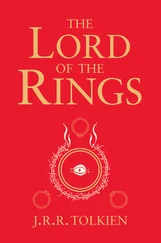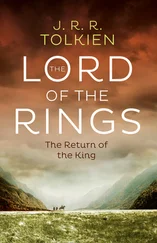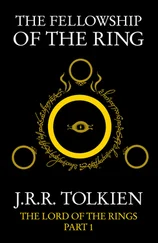‘… O thou ale thou drink delicious, let the drinkers be not moody.
Urge the people on to singing; let them shout with mouth all golden,
till our lords shall wonder at it, and our ladies ponder o’er it.
For the songs already falter, and the joyous tongues are silenced,
when the ale is ill-concocted, and bad drink is set before us;
then the minstrels fail in singing and the best of songs they sing not,
and our cherished guests are silent, and the cuckoo calls no longer…’
Beyond all this personification however there is a wealth of mythology. Every tree, wave, and hill has its nymph and spirit, distinct from the character, apparently, of each individual object. There is the nymph of the Blood and the Veins; the spirit of the rudder; there is the moon and his children, and the Sun and his (they are both masculine); there is a dim and awesome figure, the nearest approach to regal dignity in the poems, Tapio, God of the Forest, and his spouse Mielikki, and their fairy-like son and daughter Tellervo, ‘little maiden of the forest clad in soft and beauteous garments’, and her brother Nyyrikki with his red cap and blue coat; there is Jumala in the heavens (Jumala whose name is used for God in the Bible, but who in the poems is usually a god of the air and clouds); and there is Tuoni in the earth, or rather in some vague dismal region beside a river of strange things. Ahti and his wife Vellamo dwell in the waters, and there are a thousand other new and strange characters for acquaintance — Pakkanen the Frost; Lempo the spirit of Evil; Kankahatar, the goddess of weaving — but a catalogue does not inspire those that have not yet been introduced, and bores those that have. The division between the offspring of the nymphs, sprites, and other beings (you can seldom call them Gods — it is much too Olympian) and the human characters is hardly drawn at all. Väinämöinen, most venerable of evergreen patriarchs, mightiest of culture-heroes (he is the God of Music in Esthonia), most human of liars, is the son of the Wind and of Ilmatar, daughter of the Air; Kullervo, most tragic of peasant-boys, is but two generations from a swan.
I give you just this jumble of gods great and small to give you some impression of the delightful variety of the Land of Heroes. If you are not of the temper, or think you are not, for getting on with these divine and heroic personages, I assure you, as I did before, that they behave most charmingly: they all obey the great rule of the game in the Kalevala, which is to tell at least three lies before imparting accurate information, however trivial. It seems to have become a formula or polite behaviour, for no one in the Kalevala is believed until his fourth statement (which he modestly prefaces with ‘all the truth I now will tell you, though at first I lied a little’.) So much for the religion (if you can call it such) and the imaginary background.
The real scenery of the poems, the place of most of the action is Suomi, the Marshland — Finland as we call it — which the Finns themselves often name the Land of Ten Thousand Lakes. Short of going there, I imagine one could scarcely be made to see the land more vividly than by reading the Kalevala — the land of a century ago or more, at any rate, if not a land ravaged by modern progress. The poems are instinct with the love of it, of its bogs and wide marshes in which stand islands as it were formed by rising ground and sometimes topped with trees. The bogs are always with you — and a worsted or outwitted hero is invariably thrown into one. One sees the lakes and reed-fenced flats with slow rivers; the perpetual fishing; the pile-built houses — and then in winter the land covered with sleighs, and men faring over quick and firm alike on snow-shoes. Juniper, Pine, fir, aspen, birch are continually mentioned, rarely the oak, very seldom any other tree; and whatever they be nowadays in Finland the bear and wolf are in the Kalevala persons of great importance, and many sub-arctic animals figure in it too, that we do not know in England. The customs are all strange and so are the colours of everyday life; the pleasures and the dangers are
[ The typescript stops here in mid-phrase on the last line of the page. The final two words, ‘dangers are’ are jammed in just beneath and partially overlapping the line above them, as if the paper had unexpectedly run out before the writer stopped typing. A hand-written comment in ink below the text notes: ‘[Text breaks off here].’ What would have been the following page apparently never was typed, but we may conjecture that had it been, it would have conformed more or less to the final page and three quarters of the manuscript draft. ]
99 sudden collapse of the proper speaker. That Tolkien was filling in for two collapsed speakers some five to ten years apart, while not impossible, seems to stretch credibility. But since there is no evidence that this version of the talk was ever given, the opening sentence may simply have been transcribed without editing from the earlier version.
literature so very unlike. Note that the word is now spelled with one t .
103 taken the position. A military expression, referring to capture of an enemy redoubt, not the assumption of a political or philosophical stance in argument.
104 weird tales. This was the title of an American magazine of pulp fantasy fiction, first published in 1923, but not widely circulated in England. Tolkien’s allusion (if such it is) is likelier to have been to E.T.A. Hoffmann’s collection of stories, Weird Tales , translated from the German by J.T. Bealby and published in England in 1884.
105 I would that we had more of it left — something of the same sort that belonged to the English. This statement, misleadingly associated in Humphrey Carpenter’s biography with Tolkien’s undergraduate time at Oxford, does not appear in the manuscript draft of 1914–15, written while he was still a student and before he went to war. It thus comes out of a different context from the original talk with which Carpenter conflated it, and is all the more to be associated with Tolkien’s burgeoning idea of a ‘mythology for England’. The remark was Tolkien’s response to the myth-and-nationalism movement that spread through Western Europe and the British Isles in the 19th and early 20th centuries but had been brought to a halt by the 1914 war. Out of that pre-war movement came Wilhelm Grimm’s Kinder- und Hausmärchen , Jacob Grimm’s Deutsche Mythologie , Jeremiah Curtin’s Myths and Folklore of Ireland , Moe and Asbjørnsen’s Norske Folkeeventyr , Lady Guest’s translation of the Welsh Mabinogion , in addition to Elias Lönnrot’s Old Kalevala (1835) and expanded Kalevala (1849) and a host of other myth and folklore collections.
107 a no longer understood tradition. The 19th- and early 20th-century view of Welsh myth as seen in the Mabinogion was of a once-coherent concept behind the stories that had been garbled and misunderstood over time, partly through the supervention of Christianity and partly through the limited acquaintance of Christian redactors with the original stories.
108 the catalogue of the heroes of Arthur’s court in the story of Kilhwch and Olwen. The Arthurian Court List is a ‘run’ of some 260 names, some historical, some legendary, some alleged to be Arthur’s relatives, some obviously fanciful, such as Clust mab Clustfeinad , ‘Ear son of Hearer’ and Drem mab Dremhidydd , ‘Sight son of Seer’. The recitation would have been a tour de force for the bard, as well as an evocation of a host of other untold stories.
Читать дальше
